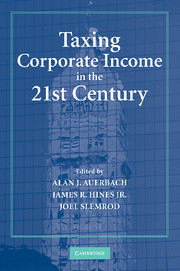Book contents
- Frontmatter
- Contents
- Contributors
- Preface
- 1 The Effects of Taxes on Market Responses to Dividend Announcements and Payments: What Can We Learn from the 2003 Dividend Tax Cut?
- Comments
- Comments
- 2 Dissecting Dividend Decisions: Some Clues about the Effects of Dividend Taxation from Recent UK Reforms
- Comments
- Comments
- 3 The 2003 Dividend Tax Cuts and the Value of the Firm: An Event Study
- Comments
- Comments
- 4 How Elastic Is the Corporate Income Tax Base?
- Comments
- Comments
- 5 An Empirical Examination of Corporate Tax Noncompliance
- Comments
- Comments
- 6 On the Extent, Growth, and Efficiency Consequences of State Business Tax Planning
- Comments
- Comments
- 7 Corporate Taxation and International Competition
- Comments
- Comments
- 8 The Changing Role of Auditors in Corporate Tax Planning
- Comments
- Comments
- 9 Taxation and the Evolution of Aggregate Corporate Ownership Concentration
- Comments
- Comments
- Index
- References
5 - An Empirical Examination of Corporate Tax Noncompliance
Published online by Cambridge University Press: 30 July 2009
- Frontmatter
- Contents
- Contributors
- Preface
- 1 The Effects of Taxes on Market Responses to Dividend Announcements and Payments: What Can We Learn from the 2003 Dividend Tax Cut?
- Comments
- Comments
- 2 Dissecting Dividend Decisions: Some Clues about the Effects of Dividend Taxation from Recent UK Reforms
- Comments
- Comments
- 3 The 2003 Dividend Tax Cuts and the Value of the Firm: An Event Study
- Comments
- Comments
- 4 How Elastic Is the Corporate Income Tax Base?
- Comments
- Comments
- 5 An Empirical Examination of Corporate Tax Noncompliance
- Comments
- Comments
- 6 On the Extent, Growth, and Efficiency Consequences of State Business Tax Planning
- Comments
- Comments
- 7 Corporate Taxation and International Competition
- Comments
- Comments
- 8 The Changing Role of Auditors in Corporate Tax Planning
- Comments
- Comments
- 9 Taxation and the Evolution of Aggregate Corporate Ownership Concentration
- Comments
- Comments
- Index
- References
Summary
We appreciate guidance on data questions from Richard Denesha, Donald Lee, John Miller, and Dick Teed. We are grateful for comments on a presentation of preliminary results received from Charles Brown, James Hines, and other members of the University of Michigan public finance workshop and for comments received at the conference from discussants Joe Bankman and Brian Erard, and several other participants.
The Internal Revenue Service (IRS) provided confidential tax information to one of the authors pursuant to provisions of the Internal Revenue Code that allow disclosure of information to a contractor to the extent necessary to perform a research contract for the IRS. None of the confidential tax information received from the IRS is disclosed in this chapter. Statistical aggregates were used so that a specific taxpayer cannot be identified from information supplied by the IRS. Information in this chapter that identifies specific companies was not provided by the IRS and came from public sources, such as reports to shareholders.
Introduction and motivation
This chapter examines the extent and nature of corporate tax noncompliance using previously undisclosed Internal Revenue Service (IRS) operational audits and appeals data merged with confidential tax return data. The extent of tax noncompliance is primarily measured as the level of proposed tax deficiencies under IRS audit, although we also investigate the amount of the proposed deficiencies that are upheld after taxpayer appeals.
- Type
- Chapter
- Information
- Taxing Corporate Income in the 21st Century , pp. 171 - 210Publisher: Cambridge University PressPrint publication year: 2007
References
- 75
- Cited by



